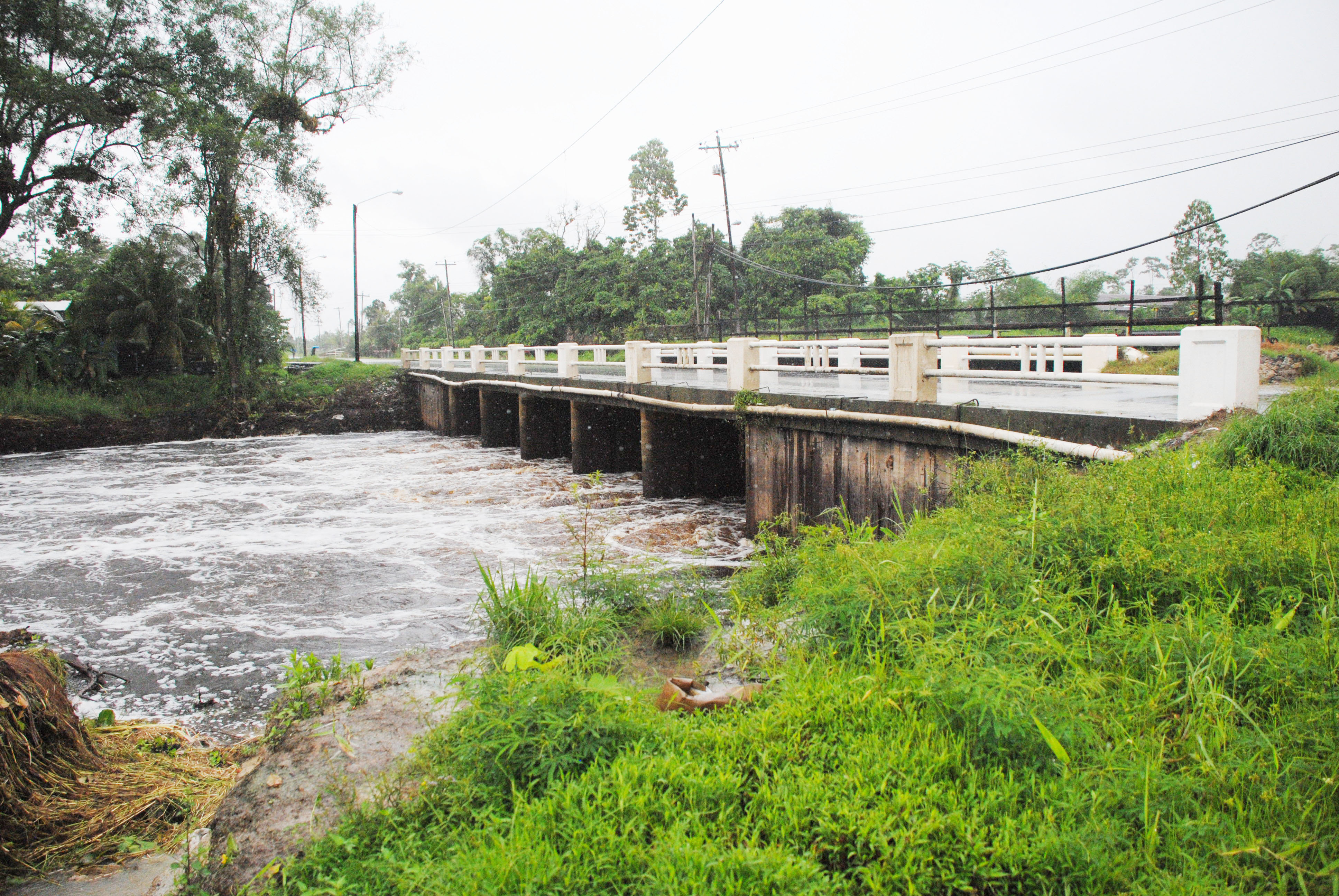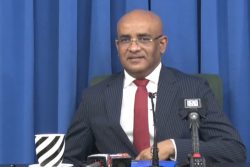The state of the East Demerara Water Conservancy (EDWC) is cause for concern for some knowledgeable engineers, who say the facility remains inadequately managed despite the large investments being made by the government.
Data provided by the Ministry of Agriculture indicate that from 2003 to 2009 over $1.8 billion have been spent upgrading the EDWC. The Ministry of Agriculture, through the National Drainage and Irrigation Authority (NDIA), has also been implementing aspects of the US$3.8 million Conservancy Adaptation Project (CAP) funded by the World Bank.
Early last week, following heavy rainfall the water in the EDWC rose to a dangerously high level and had to be released through the Lama and Maduni sluices into the Mahaica Creek, resulting in extensive flooding and damage to bordering farms and homes. Following more rainfall yesterday, water was once again released through these sluices.
Former government engineer Charles Sohan, in a letter published in Friday’s edition of the Stabroek News, said the mere fact that this had to be done suggests that “the other EDWC relief structures were not being operated at recommended intervention levels and hence the rapid rise in water levels in the conservancy were the result of poor water management rather than the start of La Niña.
 “Flood control cannot be managed on an emergency basis, with a little excavation here, moving a mobile pump there, and building a revetment yonder, the MOA has to come up with an executable comprehensive plan to improve flood protection for people living on the densely populated lowlands with critical near-term civil works to increase drainage relief capacity to handle intense rainfall immediately.”
“Flood control cannot be managed on an emergency basis, with a little excavation here, moving a mobile pump there, and building a revetment yonder, the MOA has to come up with an executable comprehensive plan to improve flood protection for people living on the densely populated lowlands with critical near-term civil works to increase drainage relief capacity to handle intense rainfall immediately.”
Speaking to Stabroek News recently, Sohan stated that while work is being done on the EDWC very often the best engineering decisions are not made. “Unfortunately ministers are micromanaging most of the works,” he said, adding that the engineers are basically doing what they are being told.
Questioned as to what should be done to improve the conservancy, Sohan said that the creeks that flow into the conservancy such as the Maduni should be cleared out so that the water could flow quickly. Sohan said he is in favour of the current exercise by the Ministry of Agriculture to dig some channels from Mahaica to the East Bank Demerara.
Further, Sohan said, there are a lot of outlets along the coast that are silted up that should be cleared. According to him, the sugar estates along the coast have blocked a number of outlets from the conservancy to the Atlantic Ocean.
Addressing the issue of siltation caused by vegetation, Sohan said the EDWC should be excavated at least once or twice a year. He said that in areas where there are rice fields, fertilizer may enter the waterway causing weeds to grow at a rapid pace. He said they should prepare to clear weeds before the rainy season.
Senior University of Guyana (UG) Lecturer and former engineer Maurice Veecock, in a public lecture last year at UG stated that one of the main problems affecting the conservancy was heavy siltation. Veecock said the network of creeks within the conservancy to conduct water from the east to the west in order to increase discharge flows to the Demerara River had been impeded by growth of vegetation. “This network of internal waterways is impeded by vegetation growth, thus resulting in restricted water flows to the west and causing water to be impounded along the eastern side of the conservancy,” he said.
Sohan, however, does not lay the blame for the unsatisfactory condition of the conservancy on the current administration alone. According to him, little attention had been paid to the EDWC for decades prior to the 2005 Great Flood. Sohan opined that in the 1960s, there was a very good drainage system. “But everything fell away because of politics,” he lamented. “There was something good about the system but bad management has allowed the system to run into disrepair.” He said back in the 1960s, there were engineers all across the country in the Neighbourhood Democratic Councils who would examine all engineering issues that would rise up in various areas. He said that the NDCs these days do not have competent people.
When Melvyn Sankies, former President of the Guyana Association of Professional Engineers (GAPE), was asked about the state of the EDWC, he told Stabroek News that not enough attention was paid to the conservancy in the 1990s, after the present administration assumed office. He directed this newspaper to a newsletter produced by GAPE which focused on drainage-related problems of Georgetown, the East Coast Demerara and West Coast Berbice. The editorial stated that the Mahaica, Mahaicony, Abary (MMA) scheme had by 1983 helped to relieve flooding on the upper East Coast but “deliberate lack of maintenance in the 90s led to flooding once again.” GAPE said that unless note was taken of what had occurred in the past, the same mistake could be made again.
Agriculture Minister Robert Persaud did not respond to recent queries by this newspaper on this issue. However, according to MOA data regarding expenditure on the EDWC, in 2003, a total of $108.5 million had been pent on emergency works on the EDWC embankment. In 2004, a total of $37.5 million was spent on rehabilitation on the EDWC embankment. In 2005, the general cost for rehabilitation of drainage and irrigation infrastructure was $952.001 million. This included the dredging and embankment works in the EDWC, flood relief works on Cunha head regulator and excavation of the Cunha channel, the rehabilitation of Kofi canal and sluice and the construction of the access road to Flagstaff. Money was also used to excavate Shanks canal, raise the embankment and raise the crown dam from Two Friends to Haslington.
In 2006, a total of $47.583 million was spent on emergency works on the conservancy and for revetment and embankment works on it. During the following year, some $215.994 million was expended on maintenance works on embankment and waterways, rental and construction of pontoons and the construction/resuscitation of 18 miles internal waterways. An additional $204.5 million was spent on maintenance works on embankment and waterways and on the acquisition of three excavators. In 2009, according to the ministry, $272.299 million was spent on maintenance works on the embankment and waterways, the rehabilitation of the Lama sluice, the acquisition of a punt and two pontoons as well as two excavators, two aluminium boats and one airboat along with two outboard engines.
Last year, Sohan, in a letter, had criticized the NDIA saying that despite the considerable grants and budgetary allocations, the efforts to improve the flood relief capacity of the EDWC were being done in a “haphazard fashion”. He had said then that it was evident that the NDIA lacked an implementation and concerted maintenance and rehabilitation programme to effectively maintain and operate the EDWC.
Senior Civil Engineer in the Ministry of Agriculture Frederick Flatts rejected the claims that the NDIA was doing its work haphazardly. “The NDIA is methodically and strategically improving the functioning of the conservancy on a daily basis,” Flatts said. He also said that several improvements have been made in keeping with the CAP.
One intervention being made by the government is the Hope Canal. Work on the facility started last year October. There has been much debate as to whether there are cheaper and more viable alternatives available for drainage of the EDWC. Last week, Agriculture Minister Robert Persaud said the recent flooding along the East Coast Demerara further demonstrated why the Hope Canal is needed. Persaud said too that when the canal becomes operational the Lama and Maduni sluices will no longer be used.
However, Sohan, in his letter on Friday, disagreed with Persaud stating that while the Hope Canal may help with the problem, a recent evaluation by consultants indicated that this canal cannot be used as a substitute for the Lama and Maduni.
“Further, during periods of heavy rainfall, closure of these sluices with the canal operating would increase the risk of the overtopping of the EDWC dam since it would not be possible to maintain conservancy levels at 58.50 GD,” Sohan stated.
Developed in 1880, the primary function of the conservancy is to store water for irrigation of sugar cane plantations, rice fields and other cash crops during periods of drought. The northern side of the conservancy dam also protects the land between the conservancy and the sea (the coastal zone) against flooding by water from rainfall in the southern catchment area. The conservancy was formed using the natural gravity water flow from the upper southern parts of the country and has a bearing capacity of more than 100 square miles of water. At present, there are 6 main flood relief structures and channels. Three are located on the conservancy’s eastern side: the Maduni, Lama (stop off) and the Lama small sluice which drain to the Mahaica River. The other three – Cunha, Land of Canaan and Kofi- drain into the Demerara River.









